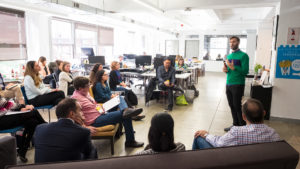#Leadership : These are the Most Important Minutes of Any #Meeting …Look for These Moments in your #Meetings and then Try Shape Future Meetings to have More of Them.
Few people like meetings, and that’s probably because they’re increasingly overtaking the workday. Over the past 50 years meetings have grown from less than 10 hours a week to nearly 23 hours, not including impromptu gatherings, Harvard Business Review reports. That’s more than half of our workweek.
“Meetings may seem too frustrating and too numerous, but they continue because they’re the center for getting work done and building relationships,” says Chris Battles, senior vice president and general manager of communications and collaboration for LogMeIn, provider of collaboration software including the meeting platform GoToMeeting. “Real-time, face-to-face interaction, even at distance, unlocks insight, and that’s powerful.”
The reason meetings get a bad reputation is because their powerful moments are often allowed to slip away, says Battles. “We may have too many things to address or time constraints due to scheduling meetings back to back,” he says. “This results in the ‘gold’ being lost.”
You can reenergize your meetings by learning to recognize the most important minutes and by setting up a system that creates more of them.
LOOK FOR VERBAL AND NONVERBAL CUES
Identify critical points in your meetings by paying attention to the language of the participants. “We’ve all been in meetings where we’re bored senseless, checking our phone and completely disengaged,” says Battles. “You can tell when a spot in the meeting hits home when people suddenly become physically present and emotionally present.”
Watch for people who start taking notes or lean in. Another sign is when people begin to contribute. They’re not just paying attention; they’re adding their own insights.
“It’s those ‘Yes, and…’ conversations,” says Battles. “It’s the part of the meeting when people are open to the information and how relates to them. It’s when they talk about how the information personally impacts their world.”
When these moments happen, don’t smother them. Instead, let them come to fruition. “When people perk up around topic, engage them and get their perspective,” he says. “Pull the person into the meeting by asking questions and drawing them into a conversation.”
Like this Article? Share It ! You now can easily enjoy/follow/share Today our Award Winning Articles/Blogs with Now Over 2.5 Million Growing Participates Worldwide in our various Social Media formats below:
FSC LinkedIn Network: www.linkedin.com/in/fscnetwork
Facebook: http://www.facebook.com/pages/First-Sun-Consulting-LLC-Outplacement-Services/213542315355343?sk=wall
Google+: https://plus.google.com/115673713231115398101/posts?hl=en
Twitter: Follow us @ firstsunllc
Question: Want the ‘the best/current articles/blogs on the web’ on Job Search, Resume, Advancing/Changing your Career, or simply Managing People?
Answer: Simply go to our FSC Career Blog below & type(#career, #leadership, #life) in Blog Search:https://www.firstsun.com/fsc-career-blog/
What Skill Sets do You have to be ‘Sharpened’ ?
Continue of article:
MAKE SURE TO CREATE A CULTURE OF COLLABORATION
Fostering important meeting moments requires paying attention to your culture. If your meetings simply present content and don’t allow engagement, it will be difficult to get those magic moments where interaction and discussion are going. Create a culture of collaboration by allowing time for questions and regularly calling on attendees for input.
“Attendees need to be free to speak up and pull others in to engage,” says Battles. “This requires that your meetings are considered a safety zone and employees trust that the norm is that they can contribute.”
HAVE A FLEXIBLE AGENDA
Often meetings follow the agenda too closely; it’s written for a reason, but it doesn’t have to be set in stone, says Battles. “When you have six things to cover, it’s tempting to close discussions too fast to get onto the next topic,” he says. “When you see momentum and energy building around one thing, stay with it, and get back to the others later.”
Override the agenda by being present and aware of what’s happening in your meeting, instead of just letting the meeting happen. “Meetings are meant to create discussion with real time interaction,” says Battles. “If not, an email would have been sufficient.”
CAPTURE THE “GOLD”
When attendees are engaged, capture the content was most interesting. Was it a topic, idea, or certain speaker? Take notes, but make sure to record actions.
“When you get to an animated state, identify next steps,” says Battles. “Do this before you move on to take advantage of the energy.”
From executive to staff meetings to team huddles, looking for those golden minutes creates a different perspective for the organizer and makes meetings at your company not so unbearable.
“Our days are often one meeting after another,” says Battles. “In each one, though, look for the great moment to take with you. Track those and use them to help participants engage with your content later.”
FastCompany.com | May 16, 2018 | BY STEPHANIE VOZZA 3 MINUTE READ


